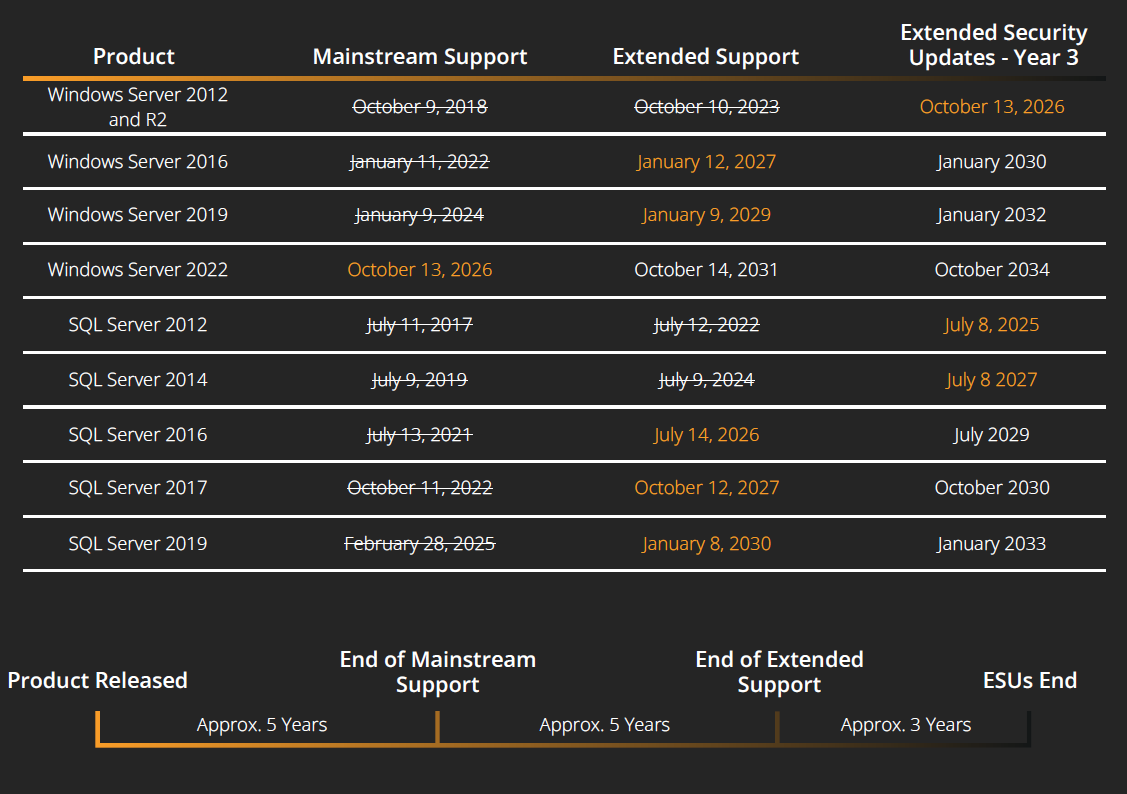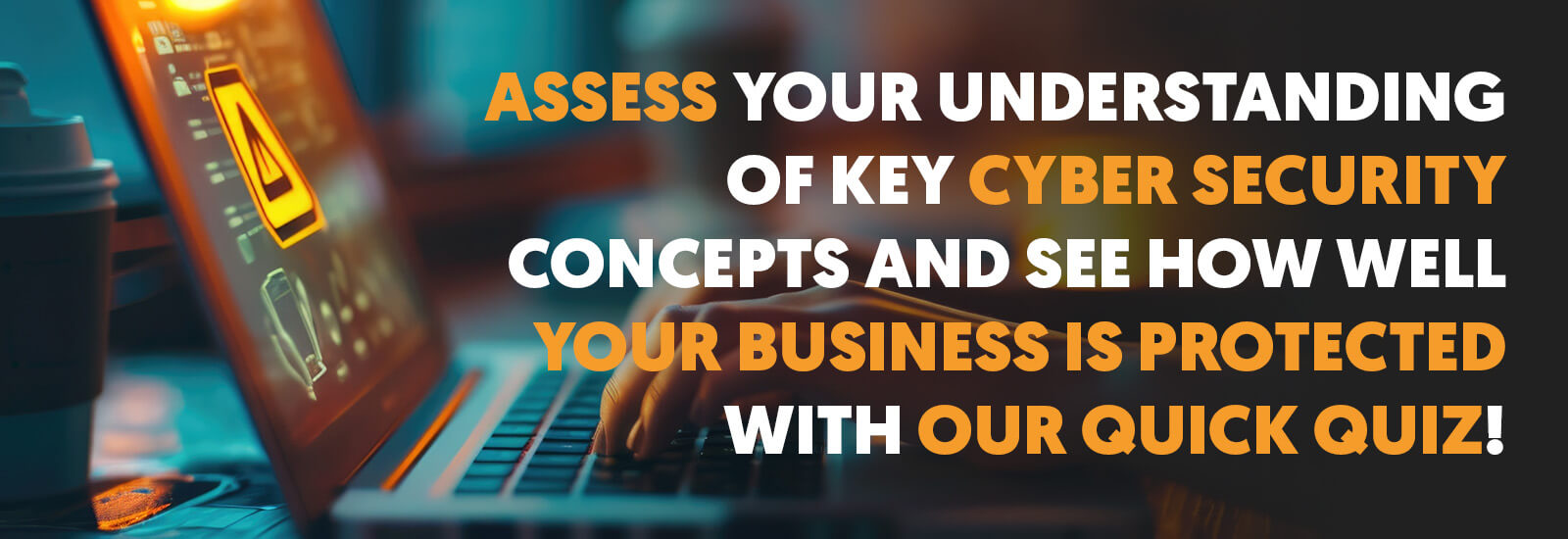Article Introduction
When Microsoft releases software like Windows Server or SQL Server, it comes with a lifecycle of support, updates, and security patches. But once that lifecycle ends, the software reaches End-of-Life (EOL), and continuing to use it can expose your business to serious risks.
Many small and medium-sized businesses (SMBs) still rely on outdated systems like Windows Server 2012 or SQL Server 2014. With Windows Server 2016 and SQL Server 2016 or 2017 approaching EOL in the next few years, now is the time to act.
The Hidden Dangers of End-of-Life Software
Cybersecurity Threats
Once software reaches EOL, it no longer receives security updates. This leaves your systems vulnerable to cyberattacks. A stark example is the 2017 WannaCry ransomware attack, which exploited outdated Windows Server versions and cost the NHS over £92 million.
Compliance Challenges
Regulations like GDPR, Cyber Essentials, and ISO standards require supported software. Running EOL systems could mean non-compliance, leading to fines and reputational damage.
Operational Disruptions
Unsupported software often leads to:
- Lack of vendor support
- Slower performance
- Increased downtime
- Knowledge loss when internal fixes are undocumented
Understanding Microsoft’s Software Lifecycle
Microsoft server products, such as Windows Server and SQL Server, follow a clearly defined lifecycle that determines how long they receive updates and support. This lifecycle is crucial for IT planning, budgeting, and maintaining a secure and compliant infrastructure. It consists of four key stages:
- Mainstream Support (Approximately 5 Years)
This is the initial phase after a product is released. During this period, Microsoft provides:
- Full technical support
- Regular security updates
- Non-security updates (e.g. performance improvements, bug fixes)
- Feature enhancements and quality-of-life improvements
For example, during the mainstream support phase of Windows Server 2019, Microsoft released over 60 updates that improved performance, enhanced compatibility with Admin Center, and addressed user feedback.
- Extended Support (Approximately 5 Years)
- Once mainstream support ends, the product enters extended support. In this phase:
- Only critical security updates are provided
- No new features or design changes are introduced
- Technical support is limited and may require additional fees
This stage is essentially a grace period, giving organisations time to plan and execute a migration to a newer version. For instance, Windows Server 2019 entered extended support in January 2024 and continues to receive security patches, but no new functionality.
- Extended Security Updates (ESUs) (Up to 3 Years)
In special cases, Microsoft offers Extended Security Updates for an additional three years. These are:
- Only available for specific versions
- Limited to critical security patches
- Often expensive and only available to customers with Software Assurance or those who migrate to Azure
ESUs are designed to give businesses more time to complete their migration, but they should not be seen as a long-term solution. For on-premises environments, ESUs can be prohibitively costly and are not guaranteed for all organisations.
- Post-Support (End of Life)
After extended support and any ESUs expire, the product is officially considered end-of-life. At this point:
- No updates of any kind are provided
- No technical support is available from Microsoft
- The software becomes increasingly vulnerable to security threats
Running software in this phase is highly risky. Any vulnerabilities discovered will remain unpatched, leaving systems exposed to cyberattacks and compliance violations.
Is Your Business at Risk?
If you are unsure whether your systems are up to date, ask yourself:
- Are any servers over 5 years old?
- Are employees complaining about slow systems?
- Do you know which software versions are in use?
A software audit by a managed service provider like Extech Cloud can help identify risks and plan your next steps.
What Are Your Options?
Option 1: Upgrade On-Premises Servers
While technically possible, upgrading often requires new hardware, which is an expensive and resource-heavy process. You will also need to over-provision for peak usage, which leads to underutilised resources.
Option 2: Migrate to Microsoft Azure
Azure offers:
- Free ESUs for eligible systems
- No capital expenditure, just monthly billing
- Scalable virtual machines and managed databases
- Reduced reliance on in-house IT expertise
Why Microsoft Azure is Ideal for SMBs
From Capital Expenditure (CAPEX) to Operational Expenditure (OPEX)
Microsoft Azure eliminates the need for costly hardware, cooling, and power. You pay only for what you use, making budgeting easier and more predictable.
Built-In Security and Resilience
Azure includes:
- Azure Firewall
- DDoS Protection
- Microsoft Sentinel
- Defender for Cloud
Your data is stored offsite, ensuring business continuity even during local outages.
Scalability and Remote Access
Azure enables secure access from any device, anywhere. This is perfect for hybrid workforces and growing businesses.
Innovation at Your Fingertips
With Microsoft Azure, you can explore advanced tools like:
- Microsoft Fabric for analytics
- Azure AI services
- Integration with OpenAI, Meta, and more
Choosing the Right Path
Whether you upgrade or migrate, the right solution depends on your infrastructure, budget, and goals. For most SMBs, Azure offers a future-proof, secure, and cost-effective path forward.
End-of-Life Readiness Checklist
- Are you unsure of which versions of operating systems or applications are in use at your business?
- Are any of them over 5 years old?
- Is your server or key software version no longer supported?
- Are your employees complaining about slow systems?
If you answered yes to any of these, it is time to act.
Let Extech Cloud Help You Modernise
At Extech Cloud, we specialise in helping SMBs transition from legacy systems to modern, secure platforms like Microsoft Azure. From software audits to full migrations, we handle everything so you can focus on growing your business.
If you’d like to know more, read our more in-depth eBook on the topic.
Speak with our experts and start your journey to a more secure, scalable future.




